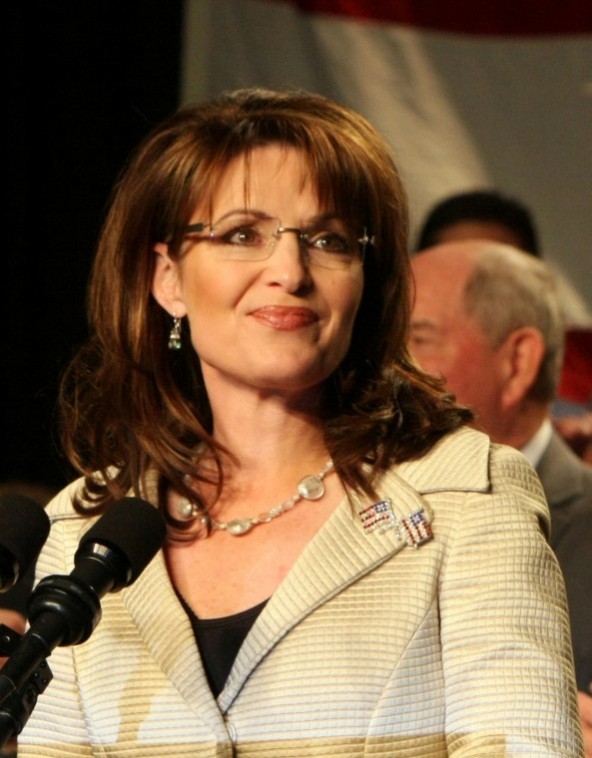Sarah Palin: Her Early Career
December 12, 2009
Motivated by concerns that revenue from a new Wasilla sales tax
would not be spent wisely,[32] Palin was elected to the city
council of Wasilla in 1992. She won 530 votes to 310.[33][34] She
ran for reelection in 1995, winning by 413 votes to 185,[35] but
did not complete her second term on the city council because she
was elected mayor in 1996. Throughout her tenure on the city
council and the rest of her career, Palin has been a registered
Republican.
Wasilla city council
Motivated by concerns that revenue from a new Wasilla sales tax would not be spent wisely,[32] Palin was elected to the city council of Wasilla in 1992. She won 530 votes to 310.[33][34] She ran for reelection in 1995, winning by 413 votes to 185,[35] but did not complete her second term on the city council because she was elected mayor in 1996. Throughout her tenure on the city council and the rest of her career, Palin has been a registered Republican.[36]
Mayor of Wasilla
Palin served two three-year terms[37] (1996–2002) as the mayor of Wasilla. In 1996, she defeated three-term incumbent mayor John Stein,[38] on a platform targeting wasteful spending and high taxes.[14] Stein says that Palin introduced abortion, gun rights, and term limits as campaign issues.[39] Although the election was a nonpartisan blanket primary, the state Republican Party ran advertisements on her behalf.[39] At the conclusion of Palin’s tenure as mayor in 2002, the city had about 6,300 residents.[40] In 2008, Wasilla’s mayor credited Palin’s tax cuts and infrastructural improvements with helping the local economy, “br[inging] the big-box stores to Wasilla, … helping Wasilla grow and draw 50,000 shoppers a day.”[41] The Boston Globe quoted a local business owner as crediting Palin with making the town “more of a community … It’s no longer a little strip town that you can blow through in a heartbeat.”[42]
First term
Shortly after taking office in October 1996, Palin consolidated the position of museum director and asked for updated resumes and resignation letters from “city department heads who had been loyal to Stein,”[43] including the police chief, public works director, finance director, and librarian.[44] Palin stated this request was to find out their intentions and whether they supported her.[44] She temporarily required department heads to get her approval before talking to reporters, saying that they first needed to become acquainted with her administration’s policies.[44] She created the position of city administrator,[39] and reduced her own $68,000 salary by 10%, although by mid-1998 this was reversed by the city council.[45]
During her first year in office, Palin kept a jar with the names of Wasilla residents on her desk. Once a week, she pulled a name from it and picked up the phone; she would ask: “How’s the city doing?”[46] Using income generated by a 2% sales tax that was enacted before she was elected to the city council,[47] Palin cut property taxes by 75% and eliminated personal property and business inventory taxes.[38][48] Using municipal bonds, she made improvements to the roads and sewers, and increased funding to the Police Department.[39] She also oversaw new bike paths and procured funding for storm-water treatment to protect freshwater resources.[38] At the same time, the city reduced spending on the town museum and stopped construction of a new library and city hall.[38]
Palin ran for re-election against Stein in 1999 and won, with 74% of the vote.[49] She was also elected president of the Alaska Conference of Mayors.[50]
Palin appointed Charles Fannon to replace Stambaugh as police chief.[37][when?]
Second term
During her second term as mayor, Palin introduced a ballot measure proposing the construction of a municipal sports center to be financed by a 0.5% sales tax increase.[51] The $14.7 million Wasilla Multi-Use Sports Complex was built on time and under budget, but the city spent an additional $1.3 million because of an eminent domain lawsuit caused by the failure to obtain clear title to the property before beginning construction.[51] The city’s long-term debt grew from about $1 million to $25 million through voter-approved indebtedness of $15 million for the sports complex, $5.5 million for street projects, and $3 million for water improvement projects. A city council member defended the spending increases as being caused by the city’s growth during that time.[52]
Palin also joined with nearby communities in jointly hiring the Anchorage-based lobbying firm of Robertson, Monagle & Eastaugh to lobby for federal funds. The firm secured nearly $8 million in earmarked funds for the Wasilla city government.[53] Earmarks included $500,000 for a youth shelter, $1.9 million for a transportation hub, and $900,000 for sewer repairs.[54] Term limits in the Wasilla Municipal Code proscribe candidates from running for more than two consecutive terms.[37]








